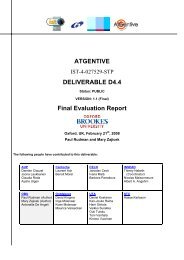LingHe Simulation - INSEAD CALT
LingHe Simulation - INSEAD CALT
LingHe Simulation - INSEAD CALT
You also want an ePaper? Increase the reach of your titles
YUMPU automatically turns print PDFs into web optimized ePapers that Google loves.
T12 0.427<br />
T16<br />
T15<br />
-0.723<br />
0.629<br />
No te: T2: short breaks; T3: directive; T4: electronic mail; T6: neutralize resisters; T7: task force; T9:<br />
external consultant; T11: face to face meeting; T12: bulletin board; T13: internal magazine;<br />
T14: workshop; T15: management training; T16: memorandum; T17: social network; T18:<br />
gather information; T19: pilot test; T20: process mapping; T23: top management meeting; T25:<br />
staff meeting discussion; T27: “sandwich”<br />
Although factor analysis did not result in the five groupings with the same tactics as initially<br />
formulated (see higher), the first two factors, together explaining 31.176 % of the variance,<br />
include all Diagnostic/Gather Information and Communication tactics, as well as two of the<br />
Implementation tactics (Workshop and Pilot Test) that are moreover ranked the highest in the<br />
factor groups. The remaining three factors, together explaining 24.684% of the variance, include<br />
all Provide Information tactics and two out of three Compulsion tactics (Directive, Neutralize<br />
Resisters).<br />
By and large, the first factor group may be called “collecting information regarding change attitudes”<br />
and includes Pilot Test, Gather Information, Social Networks, Process Mapping, Staff Meeting<br />
Discussion and The “Sandwich”. Authors conclude that managers tended to recognize the need<br />
to prepare and inform themselves about the organization, with attention given mainly to its<br />
formal structures.<br />
The second factor group includes most communication tactics plus the Workshop and<br />
Short Breaks tactics, and might therefore be called “Intensive Communication” tactics as they imply<br />
individual and top management communication, understanding informal influence channels,<br />
providing external expert opinion and interactive demonstration.<br />
The third factor group combined Directive and Neutralize Resisters, a clear use of compulsion<br />
(or formal authority), as well as Electronic Mail. It is interesting to note that the latter finds itself<br />
together with all other information-providing tactics in the bottom three factor groups with least<br />
explanatory power, an indication that one-way (mass) communication was not well regarded<br />
among participating managers as a way to influence people’s opinions, attitudes or behaviors.<br />
Management Training could possibly be regarded in a similar vein, as this tactic implies that the<br />
subjects are supposed to comply with what the trainer requires them to do. Overall, tactics that<br />
were impersonal if not authoritative appeared to score relatively poorly among participating<br />
managers.<br />
13
















